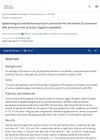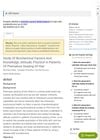Search
for
Sort by
Research
990-1000 / 1000+ results
research Clinical and Biochemical Characteristics in PCOS Women With Menstrual Abnormalities
Menstrual abnormalities in PCOS women may not greatly affect their metabolic and hormonal profile.

research Correlation Between Biochemical and Clinical Hyperandrogenism Parameters in Polycystic Ovary Syndrome in Relation to Age
The link between physical signs of high male hormones and hormone levels in women with PCOS changes with age.

research Epidemiological and Biochemical Factors (Serum Ferritin and Vitamin D) Associated with Premature Hair Graying in the Egyptian Population
Low iron levels are linked to premature graying of hair, but vitamin D levels are not.
research Epidemiology and Hemato-Biochemical Changes in Mange-Infested Camels
Mange in camels causes blood and organ damage, especially in older females.

research A Comprehensive Investigation of Biochemical Status in Patients with Telogen Effluvium: Analysis of Hb, Ferritin, Vitamin B12, Vitamin D, Thyroid Function Tests, Zinc, Copper, Biotin, and Selenium Levels
Telogen effluvium is linked to deficiencies in iron, vitamin B12, and thyroid function.

research A Study of Biochemical Factors and Knowledge, Attitude, and Practice in Patients With Premature Graying of Hair
Premature graying of hair is linked to vitamin D and B12 deficiencies, thyroid issues, iron imbalance, stress, and lifestyle habits, and affects quality of life.

research Study of Biochemical Factors and Knowledge, Attitude, Practice in Patients of Premature Greying of Hair
Low Vitamin D, Vitamin B12, and iron levels, as well as thyroid issues, are strongly linked to premature greying of hair, which also negatively affects quality of life.

research Evaluation of Some Biochemical Markers in Alopecia Areata
People with alopecia areata have different blood markers that suggest inflammation and immune system issues compared to healthy individuals.

research Clinical And Hemato-Biochemical Studies On Goats Naturally Infested With Sucking And Biting Lice
Goats infested with lice showed anemia and skin issues, which improved after treatment.